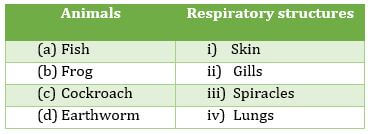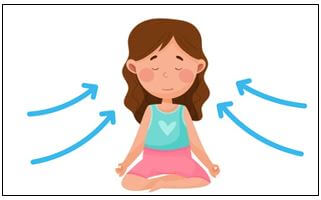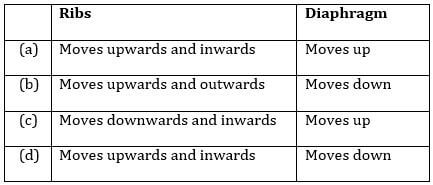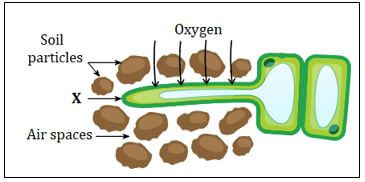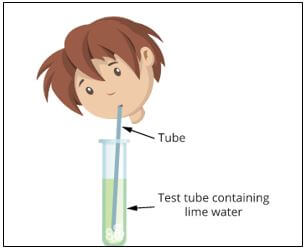Respiration in Organisms Worksheet
Objective Type Questions
- Fill in the blanks with suitable words.
(a) ……………. means taking in air rich in oxygen and giving out air rich in carbon dioxide with the help of respiratory organs.
(b) The number of times a person breathes in a minute is termed as the …………….
(c) A ……………. means one inhalation plus one exhalation. - Find the correlation.
Elephant : Lungs :: Mango tree : …………………
- The diagram below shows the human respiratory system. Label the parts A, B, C and D correctly choosing the appropriate terms from those given in the brackets.
(lungs, diaphragm, ribs, pharynx, nostrils, trachea, bronchi) - The statements given below are incorrect. Rewrite the correct statements by changing the underlined words of the statement.
(a) A large, muscular sheet called ribcage forms the floor of the chest cavity.
(b) Breathing should be avoided as it damages the lungs and can cause cancer.
(c) Smoking expels foreign particles from the inhaled air to allow dust-free, clean air to enter our body.
(d) The air we inhale, passes through the nostrils into the buccal cavity. - Match the terms in column A with appropriate terms in column B.
Multiple Choice Questions - Cells require energy to perform various functions like digestion, excretion, reproduction, and transport. From where do cells obtain this energy?
(a) Stored energy in the water which releases during nutrition
(b) Stored energy in the food which releases during respiration
(c) Stored energy in the body which releases during reproduction
(d) Stored energy in the blood which releases during transportation - The below chart lists some human activities.
riti believed that out of these activities, sleeping is the only activity in which cells do not need energy. Is Priti’s belief, correct?
(a) No, the cells require energy for all activities of the body.
(b) Yes, while sleeping, all the body cells are at rest, so energy is not required.
(c) No, reading is another activity in which energy is not needed by the cells.
(d) Yes, sleeping is the activity in which energy is not used but is released inside the body. - A researcher worked on two types of microbial cells, which were placed in two different culture plates, A and B. The table below shows the impact on cells when cultured in the absence of oxygen.
What type of microbes are likely to have been grown in culture plates A and B?
(a) A - Aerobes; B - Aerobes
(b) A - Anaerobes; B - Aerobes
(c) A - Aerobes; B - Anaerobes
(d) A - Anaerobes; B - Anaerobes - Given below are two reactions which occurs in two different organisms, A and B.
Which of the following is the best choice with respect to the above equations?
(a) A – Aerobic respiration; occurs in man
(b) A - Anaerobic respiration; occurs in yeast
(c) B - Anaerobic respiration; occurs in man
(d) B - Aerobic respiration; occurs in yeast - Soham exercised vigorously for three hours. After some time, he began to experience muscle cramps. Which of the following explains the situation correctly?
(a) Temporary deficiency of oxygen in the muscle cells
(b) Permanent deficiency of oxygen in the muscle cells
(c) Temporary deficiency of carbon dioxide in the muscle cells
(d) Permanent deficiency of carbons oxide in the muscle cells - Ranjan recorded his breathing rate at rest. After playing football for 15 minutes, he again measured his breathing rate and tabulated his observations as shown below:
What could be the reason for this change in breathing rate?
(a) To fulfil the increased demand for water by the body
(b) To fulfil the increased demand for oxygen by the body
(c) To fulfil the decreased demand for oxygen by the body
(d) To fulfil the increased demand for carbon dioxide by the body - Four different activities were performed by four students for a period of 10 minutes as shown below.
The breathing rate of all these students was measured as soon as they finished their activities. Which student will have the highest breathing rate?
(a) Isha
(b) Sujoy
(c) Aryan
(d) Neha - The given image shows a girl taking in fresh air early in the morning.
Which terminology would be the most appropriate for defining the act of taking in air inside the body?
(a) Respiration
(b) Exhalation
(c) Inhalation
(d) Breathing - While explaining the process of inhalation, a teacher asked her students to observe the expansion of their chest. The teacher explained that this happens because of the movement of the ribs and the diaphragm. Which of the following movements are likely to occur in the ribs and the diaphragm during inhalation?
- People use different methods such as trimming and waxing to get rid of nose hairs. However, some health specialists are against the idea of removing nose hair. What is the likely concern regarding the removal of nose hairs?
(a) It may affect the sensitivity of the nose for odour.
(b) The amount of oxygen inhaled will be affected.
(c) Germs and foreign particles will get entry inside the body easily.
(d) It may lead to the production of mucous in excessive amounts inside the nose. - Apurva observed a slide of the epidermal layer of a leaf. It contained the structures that help the plant to respire. What structures might have been observed by Apurva in the slide?
(a) Gills
(b) Lungs
(c) Stomata
(d) Trachea - The diagram below shows a structure ‘X’ embedded in between the soil particles. It is responsible for taking in oxygen from the air spaces.
Latika observed the diagram and concluded that the diagram depicts the process of respiration in plants. Is the claim made by Latika, correct?
(a) Yes, X is stomata, which helps the plant to take in oxygen from the soil.
(b) Yes, X is root hair, which helps the plant to take in oxygen from the soil.
(c) No; X is tracheae, which helps the earthworms to take in oxygen from the soil.
(d) No; X is spiracle, which helps the cockroaches to take in oxygen from the soil.
Subjective Questions - Prerna had participated in the cycling competition in her school. After continuous cycling, when she returned home, she experienced severe muscle cramps in her legs. Her mother advised her to take a hot water bath. How will this relieve Prerna’s condition?
- Why does an athlete breathe faster and deeper than usual even after finishing the race?
- Name the type of respiration in which the end products are -
(a) alcohol and carbon dioxide
(b) carbon dioxide and water
(c) lactic acid
- When Satish blew air into a test tube containing lime water, the solution turned milky.
(a) What is the likely source of carbon dioxide in this activity?
(b) Why did the lime water turn milky? - Why do frogs have a moist and slippery skin?
Case-Based Questions - All living organisms require energy for performing various activities and maintaining their life. This energy is obtained from the food we eat. The food has stored energy which is released slowly as and when our body requires it.
a) The breakdown of food takes place inside the cell. This process releases a lot of energy which is used by the cell for performing various activities. Which life process helps the cell to perform this function?
(a) Reproduction
(b) Transportation
(c) Cellular respiration
(d) Excretion
b) The process of respiration is said to be the reverse of ……………………….
c) List two points of differences between aerobic and anaerobic respiration.
Assertion-Reasoning Questions
Below questions consist of two statements – Assertion (A) and Reason (R). Answer these questions selecting the appropriate option given below:
- Assertion (A): One should do pranayama every day.
Reason (R): It releases more energy in the body. - Assertion (A): Insects have a network of air tubes called tracheae for gas exchange.
Reason (R): Tracheae are found only in insects and not in any other group of animals.
Explore more Science Sample papers and Solutions
-
Sample Papers for CBSE Class 7 Science Term 1 #1
-
Sample Papers for CBSE Class 7 Science Term 2 #1
-
Nutrition in Plants Worksheet
- Nutrition in Animals Worksheets
- Heat Worksheet
- Acids, Bases And Salts Worksheet
- Physical And Chemical Changes Worksheet
- Transportation In Animals And Plants Worksheet
- Reproduction in Plants Worksheet
- Motion And Time Worksheet
- Electric Current And Its Effects Worksheet
- Light Worksheet
- Forests: Our Lifeline Worksheet
- Wastewater Story Worksheet
- Competency Based Questions for CBSE Class 7 Science
- Sample Papers for CBSE Class 7 Science Term 1 #2
- Sample Papers for CBSE Class 7 Science Term 2 #2
Key Features of Study Materials of CBSE Class 7 Science:
- Easiest and most comprehensive study materials
- Designed by subject matter experts
- Revised according to the latest CBSE syllabus
- Helpful for quick revision
- ‘Ask a Doubt’ facility
- Significant improvement in marks


